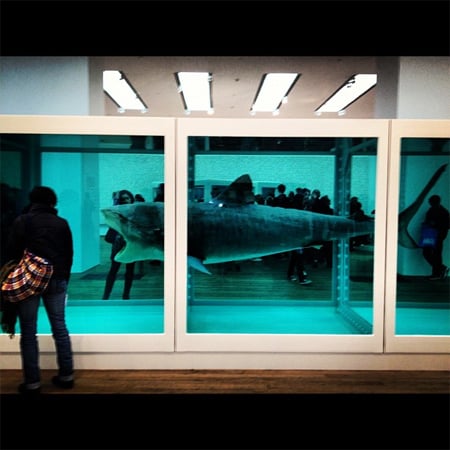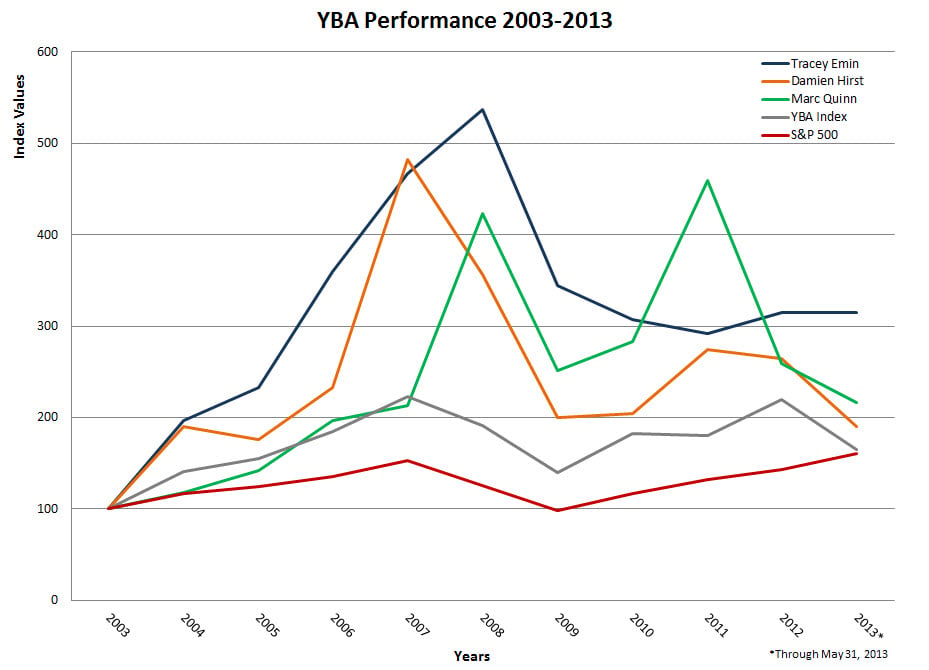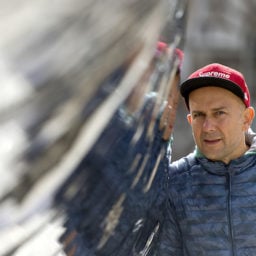

Twenty-five years ago Damien Hirst (British, b.1965) organized the Freeze exhibition in an empty London Port Authority building at Surrey Docks in London, England. This exhibition ushered in the new generation of Young British Artists, an era which Guardian critic, Jonathan Jones recently referred to as “the best 25 years in British art history.”1 Initially characterized by an entrepreneurial spirit and self-promotion, these artists quickly benefitted from media coverage resulting from Charles Saatchi’s early patronage and acknowledgment by art world brands from White Cube and Whitechapel Art Gallery to the Tate Modern and the Turner Prize. Saatchi sponsored the first official exhibition of Young British Artists in 1992, which was especially memorable for the display of Hirst’s infamous glass-encased tiger shark, The Physical Impossibility of Death in the Mind of Someone Living. This work has since become an icon of the YBA generation and Contemporary Art in general, sparking debates over the very nature of art as well as the eight-digit prices these works have commanded.

Damien Hirst, The Physical Impossibility of Death in the Mind of Someone Living, 1991, at the Tate Modern Photo by Sophie Neuendorf
Even while working with non-traditional media, from Chris Ofili’s elephant dung paintings to Sarah Lucas’s cigarette sculptures, many YBAs and their immediate successors achieved unprecedented financial success very early on in their careers. The question for many of these artists gradually became one of sustainability; once the hype around all things British faded, would their markets maintain forward motion? Hirst is the most widely cited example of meteoric success followed by slow post-recession growth, other artists have fared better after the recession, showing promising signs of growth in the past few years.
The above graph tracks the performance of several notable Young British Artists, against both the S&P 500 and the overall YBA Index. In the last 10 years, YBA artists have earned higher returns than the S&P 500, showing promising signs of growth since the crash in 2009.
Where are they now?
Hirst is the most financially successful of the YBA artists, and is surpassed only by Gerhard Richter (German, b.1932) as the all-time top-selling living artist. Best known for his infamous Pharmacy sale in 2008, Hirst’s market has struggled to rebound to pre-crash levels, with his 2012 sales volume at a fraction of what it was five years ago. Hirst’s famous Spot Paintings have retained their value even throughout the crash, and will be the subject of a major catalogue raisonné to be published this fall.
Tracey Emin (British, b.1963) has achieved higher returns than any other YBA artist in the past 10 years; since 2003, her index is over 200% benefitting from high demand and average sale prices. So far this year, Emin’s total sales volume has already exceeded 2012 levels, showing promising signs of surpassing the 2010 high.
Marc Quinn (British, b.1964) achieved four of his top five prices at auction in the last three years. Quinn’s most expensive work, Myth Venus, sold for US$1.2 million in May of 2011, marking the first time his work had broken the million dollar mark at auction. Quinn is also one of the top five highest selling YBA artists behind Hirst and Glenn Brown (British, b.1966).
For more information about the methodology of artnet Indices, please see the artnet Analytics White Paper.
Need additional analysis? artnet Analytics can work with you to create even more customized reports based on the specific needs of your auction house. For more information about custom reports, please contact Katharine Markley at
1Jonathan Jones, “Here’s to the YBAs, and the best 25 years in British art history,” The Guardian, April 30, 2013, http://www.guardian.co.uk/.







